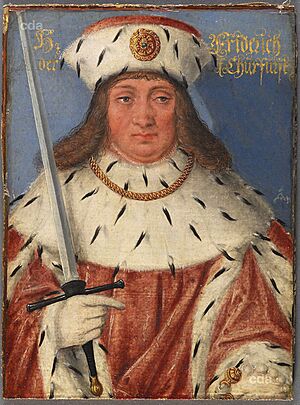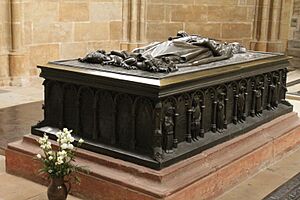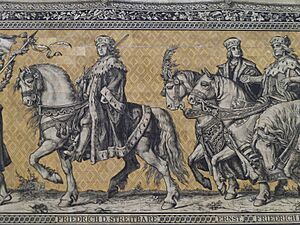Frederick I, Elector of Saxony facts for kids
Quick facts for kids Frederick I |
|
|---|---|

Portrait by Lucas Cranach the Younger
|
|
| Elector of Saxony | |
| Reign | 6 January 1423 – 4 January 1428 |
| Predecessor | Albert III |
| Successor | Frederick II |
| Margrave of Meissen | |
| Reign | 9 February 1407 – 4 January 1428 |
| Predecessor | William I |
| Successor | Frederick II |
| Born | 11 April 1370 Dresden, Margravate of Meissen, Holy Roman Empire |
| Died | 4 January 1428 (aged 57) Altenburg, Electorate of Saxony, Holy Roman Empire |
| Burial | Princes Chapel in Meissen Cathedral |
| Spouse | Catherine of Brunswick-Lüneburg |
| Issue among others... |
Frederick II, Elector of Saxony Anna, Landgravine of Hesse William III, Duke of Luxembourg |
| House | House of Wettin |
| Father | Frederick III, Landgrave of Thuringia |
| Mother | Catherine of Henneberg |
Frederick I, the Belligerent or the Warlike (German: Friedrich der Streitbare; born April 11, 1370 – died January 4, 1428) was an important ruler from the House of Wettin. He was the Margrave of Meissen starting in 1407. Later, he became the Elector of Saxony in 1423, ruling until his death.
He is sometimes confused with his cousin, Frederick IV, Landgrave of Thuringia.
Contents
Frederick's Early Life and Rule
Frederick was the oldest son of Frederick III, Landgrave of Thuringia, and Catherine of Henneberg. When his uncle, William I, Margrave of Meissen, passed away in 1407, Frederick became a governor. He shared this role in the Margraviate of Meissen with his brother William II and his cousin Frederick IV. Their lands were later divided in 1410 and 1415.
Frederick was known for helping others in conflicts. In 1388, he supported Frederick V of Hohenzollern, a burgrave from Nuremberg. In 1391, he helped the Teutonic Order against Wladislaus II of Poland. He also backed Rupert III, an Elector, in his fight for the German throne.
Becoming an Elector of Saxony
A big threat to Germany came from the Hussites, a religious group. Frederick decided to join forces with Emperor Sigismund to fight them. He played a major part in this war and had good success early on.
For his victory at the Battle of Brüx in 1421, Frederick was given the important titles of Duke and Elector. He spent a lot of money on this effort. In return, Emperor Sigismund gave him control of several places in Bohemia. On January 6, 1423, Sigismund also granted him the vacant electoral Duchy of Saxony-Wittenberg. Frederick officially took on this new role on August 1, 1425. This is when he became known as Frederick I, Duke and Elector.
With his new power, Frederick continued to fight the Hussites. He tried to get other German princes to help him. However, the Saxon army suffered a huge loss at Aussig on August 16, 1426. After his brother William died, Frederick became the sole ruler of almost all the lands belonging to the House of Wettin.
Founding the University of Leipzig
In 1409, Frederick and his brother William did something very important for education. They founded the University of Leipzig. This university was created for German students who had left the University of Prague. They left because of events related to the Western Schism, a split in the Catholic Church.
Frederick passed away in 1428 in Altenburg. He was buried in the Princes Chapel of Meissen Cathedral. He was the first ruler from the Wettin family to be buried there. Today, you can visit the cathedral and see his tomb.
Frederick's Family
Frederick I married Catherine of Brunswick-Lüneburg on February 7, 1402. Catherine passed away in 1442. They had seven children together:
- Catherine, who died when she was young.
- Frederick II, Elector of Saxony (1412–1464).
- Sigismund, who became the Bishop of Würzburg (1416–1471).
- Anna (1420–1462), who married Louis I, Landgrave of Hesse.
- Catherine (1421–1476), who married Frederick II, Elector of Brandenburg.
- Henry (1422–1435).
- William III, Duke of Luxemburg (1425–1482), who was also the Landgrave of Thuringia.
Images for kids
See also
 In Spanish: Federico I de Sajonia para niños
In Spanish: Federico I de Sajonia para niños





